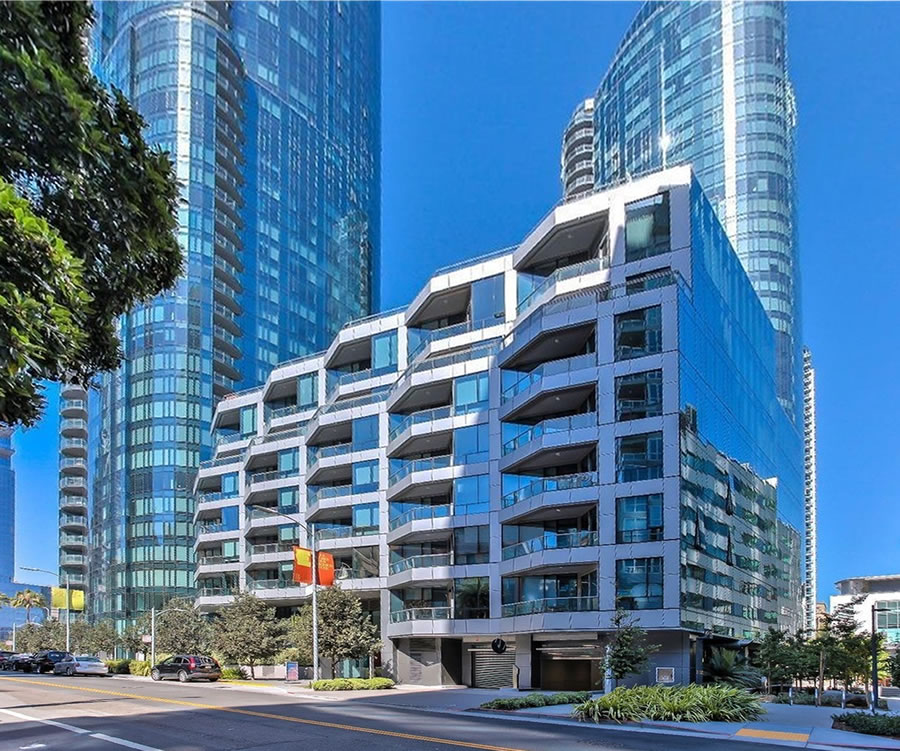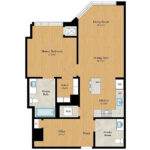Purchased for $1.225 million in May of last year, near the height of the industry-driven “wave of millionaires” misreports, the garden view unit #4C in the Lumina mid-rise at 333 Beale Street returned to the market priced at $1.268 million this past January.
The 916-sqaure-foot, one-bedroom unit is outfitted with one and a half bathrooms; wide plank hardwood floors; an open kitchen with Bosch and Gaggenau appliances (including the built-in microwave option); a 70-square-foot office/den space; and a parking space in the building’s garage.
Reduced to $1.228 million in May and then to $1.178 million in August, the sale of 333 Beale Street #4C has now closed escrow with a contract price of $1.025 million, representing a 16.3 percent drop in value for the luxury unit since the second quarter of last year on an apples-to-apples versus “median price” basis.
The Case-Shiller index for Bay Area condo values is down 2.7 percent over the same period of time.







One bedroom, garden view, and no patio units should be $500k, tops.
I agree, we are talking about San Francisco. Unfortunately the $1M 1 bedrooms are the new normal.
Factually speaking, the average one-bedroom has sold for closer to $840,000 over the past 6 months. And while that’s certainly not cheap, that ‘new normal’ would be around 7 percent cheaper than the norm at the same time last year (and well under the million dollar mark).
Still remember back in 2009, bought a 2/2 with parking on Washington & Presidio, for $623K and thought “this is expensive”. I am sure in another 15 years, this unit would look cheap at $1m…
I think you are going to be sorely disappointed in SF real estate appreciation over the next decade.
I absolutely agree with you. Any investor considering purchasing SF real estate as an investment is treading in dangerous waters. The few remaining folks I personally know who have investment real estate in SF (these are small time investors) are getting out.
Problems include the dicey job situation – especially the loss of high paying jobs – and the inability of SF to maintain its streets and infrastructure and the ongoing deterioration of the quality of life.
Garden view is generous. You are looking into your neighbor’s windows and they are looking into yours.
Given the amount of money involved, its surprising that more care isn’t taken with unit configurations and designing-in some warmth and personality. I wonder if, sometime in the future, people will be remodeling these units away from the “science lab” look.
There might be a market niche for a developer who invites early purchasers in the $800K-$1,500K range to work with an in-house design-build team to finish-out a unit to the purchaser’s specs. I’m not talking about the limited options typically provided for cabinet or flooring upgrades.
That kitchen for one million dollars. Pure insanity.
i think this is an example of assuming that prices will always increase. Yeah, all the above points are true about not having a view, garden unit with no patio. But if you need a place, have the money and assuming you won’t lose money on the deal, hey, what do you have to lose? Well, we know the answer to that now…..
It goes without saying, of course, that this owner also had to shell out the sky-high HOA for the duration of their ownership.
Even before COVID, I truly do not understand who the buyer is for this type of places. Seemingly there are plenty of them out there, both then and now.
Not a real estate agent, so II’m wondering if HOA Dues of $1,134 per month are considered “sky-high” for the larger luxury apartment buildings in this neighborhood (“The East Cut”)? I mean for buyers to live in, not investor/”boot leg” landlords.
If it seems that the amount would discourage penny ante landlords from buying units in the Lumina and renting them out, then it’s (partially) served its purpose.
HOA fees affect owner occupiers and landlords just the same…why would it discourage one more than the other? I’ve spent several years renting from landlords who themselves were paying ~$1k HOAs in East Cut and Mission Bay. They’re sky-high to me but typical for the area. Interestingly, I was browsing high rise condos in San Diego and was somewhat surprised to see equally high HOA costs on much cheaper condos.
I would much rather be a renter, than an owner/landlord, in these high rises. Sky high HOA is just one reason. The other reason is that every year you have newer building going up around you that is shinier and gets all the attention.
I’ve said it here before, but buying for the “new condo smell” is a sucker’s bet for multiple reasons. In addition to the ones you mention, there is no price transparency in buying a new condo. The developer’s most closely held secret is the list of units sold and the prices. With a condo resale, everything is on MLS. The balance of information is always in favor of the developer.
In the second quarter of 2018, there were 294,312 people working within San Francisco’s downtown commercial (C3) district. Many of those people prefer to walk, bike, or take transit to work. They would rather not fight traffic and then pay several hundred dollars per month to park. It only takes a tiny fraction of those workers to fill a residential tower like this.
Many more people work in nearby South of market buildings. If you open up a Google map of the area and look at nearby employers (Mozilla, Facebook, Price Waterhouse Coopers, PG&E, etc.), you start to see some of the folks who might want to replace a long commute with a short stroll.
If I were still with my old firm, it would be a six-minute walk from this apartment to my office. Personally, I preferred my place in a historic building in a cozier San Francisco neighborhood, despite the fact that I had a longer commute to downtown, but I can see the appeal of places like this.
I had a brief stint working for PwC with PGE as my client. Very few PGE employees (hundreds?) could afford to buy in SF. PwC directors/partners could but spend so little time in the office. Mozilla has had huge layoffs. So 1 of 5 examples seem relevant…
Well PGE is moving to Oakland, so it’s actually a good example…only for THIS thread.
The entire comment was relevant to The Before Times (right down to the citation of the estimate of commuters to jobs within San Francisco’s downtown commercial district from 2018, no less). Now, very very few white collar workers are working within San Francisco’s downtown commercial district, they are working from home and not commuting at all, so the appeal of this apartment, assuming Patrick’s analysis is correct, completely depends on things going back to the state they were in January of 2020 and that in turn depends on the pandemic ending.
The first wager requires you to believe that the majority of people working in San Francisco’s downtown commercial district don’t change their workstyles after realizing that they do not absolutely need to fight traffic five days a week and then pay several hundred dollars per month to park in order to sit in a room with a screen. Nor do they need to pay for overpriced apartments so that they can walk, bike, or take transit to said commercial district.
The second wager requires you to believe that the vaccine rollout will go well, that the new variants of the virus will be controlled or will be prevented by the existing vaccines, etc.
If either one of those serial wagers doesn’t pay out, then buyers of units like this one will lose in the short-term, like the seller for this transaction did.
I am no fan of this area, but your analysis is fundamentally flawed. Employees wont have any say as to where to work once vaccine is widely available, employers do.
And Jack Dorsey is about the only one that says employees get to WFH forever. Other than him, every single company indicates the employees need to come back to office, from JP Morgan to Netflex.
Lets all be honest, productivity is low with WFH. All the booms at Home Depot or Etsy are done during work hours. Companies just cant survive with forever WFH.
Sorry, the shift happened. No matter how hard you stamp your feet, remote is here to stay.
You’re going to see a lot of SF leases not renewed.
And your opinion on productivity is incorrect.
This is a paradigm shift part of which will remain after Covid. Companies are finding they don’t have to have an SF footprint let alone a large SF based tech workforce in the emerging telework/telecommute option. It’s possible a large hallowing out of the number of workers in this area will occur over the next few years. Thousands and thousands leaving whether for another BA locale (PGE, Blue Shield, Kredit Karma to Oakland, Stripe to SSF) or out of the state altogether.
A prolonged downturn in demand for SF residences is underway. New well paid individuals not locating to San Francisco as well as existing residents moving as their jobs shift to Oakland, other Bay Area cities or beyond. Two neighbors of mine have been with PG&E for 20 years. They are selling their homes (one has already purchased in the Oakland Hills) and not looking back The key is that San Francisco as a population and more importantly tech/jobs center will decline relative to other metros. SF real estate in not a good medium or long term investment as the factors I mentioned are long term trends.
Just to be clear, I am not saying that all employees will choose to WFH forever.
Just that enough will, for various reasons, keep working from remote locations for a period of time past the end of the pandemic. Once that happens, and middle managers get the sense that the only people howling that productivity is low for remote workers are those motivated by the need to support high real estate prices, the premium for apartments located close to high priced office space will shrink enough that for short term holding periods (like the less than a year holding period before returning to the market for the seller here), buying a unit like this one will almost certainly result in a nominal loss.
A little less of them now, sure.
But still, probably someone hedging their bet that they’ll be able to rent this out at some point… Or a tax stash. For someone to live in though? Makes little sense.